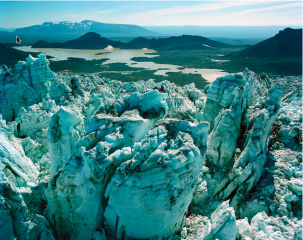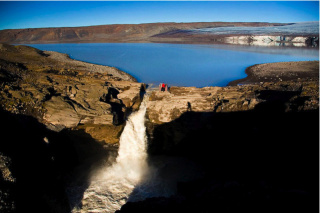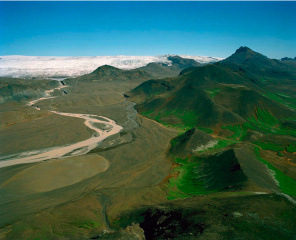Author Archive
Icelandic Santas Cause Mischief in Hengill
Update: check out the new ‘Potatoes for Heavy Industry’ film on YouTube. [In Icelandic and English]
On Saturday nine ‘jólasveinar’ wandered into the Hellisheiði Powerplant by Mount Hengill, expressing their opposition to the rise of heavy industry and other nature devastating activities in Iceland, as well as solidarity with human nature conservationists. (The jolasveinar are 13 Icelandic santas, born of a child-eating troll mother, who descend from the mountains in the days before christmas to sneak through the houses, stealing, teasing and causing mischief.) Read More
Nov 28 2007
1 Comment
Plans to Dam Farið River in Southwestern Highlands
Reykjavík Energy (OR) is examining the feasibility of harnessing Farid, a river that runs out of Hagavatn lake, south of Langjökull glacier in Iceland’s western highlands, and constructing a 30 to 40 MW hydroelectric plant there.
Farid would be dammed and another dam would also be constructed above Leynifoss waterfall, Morgunbladid reports.
The Ministry of Industry granted permission earlier this year for OR to examine this possibility and to see whether the prevention soil eruption and production of hydroelectric power could go together.
Employees of the Soil Conservation Service of Iceland have long considered damming the river to prevent soil eruption in the area since they believe it originates in the dried-up base of Hagavatn lake.
The Icelandic Institute of Natural History, however, believes that if Hagavatn lake is used as a reservoir, soil erosion from its base will increase in late winter and early summer.
Director of the Icelandic Tourist Association Ólafur Örn Haraldsson is against the plans. “A dam and a power plant will destroy one of the most spectacular land formation processes of Langjökull,” he said, adding the area is like an open and easily readable geology book.
Haraldsson said the area is becoming an increasingly popular hiking destination, which has the potential to become as popular as Laugavegur hiking route to Landmannalaugar, south Iceland.
Nov 19 2007
Climate Change-Iceland: Emissions Quota Debate Heats Up
By Lowana Veal, Inter Press Service, 19 November 2007
“I am of the opinion that Iceland should not ask for a repeat of the Iceland Provision in the upcoming climate change negotiations,” says Iceland’s environment minister Thorunn Sveinbjarnardottir.
The Iceland Provision was the exemption given to Iceland when the Kyoto Protocol went into effect in 2005. Because Iceland derives 72 percent of its energy needs from renewable energy and had little heavy industry at the time the Protocol was agreed, the country was allowed to increase its greenhouse gas emissions by 10 percent from their 1990 level, rather than decrease emissions by at least 5 percent like most of the other signatories are required to do.
During the first commitment period, 2008-2112, the Iceland Provision allows for emissions averaging 1.6 million tonnes annually of carbon dioxide from energy-intensive industries that had not existed prior to 1990.
Read More
30,000 March Against Heavy Industry in India
To all those struggling against heavy industry in India, we at Saving Iceland wish you are solidarity and strength. To have 30,000 persons on a blockade must be an incredible feeling, and a product of incredible organisation and will.
Resisting Liberalisation, Privitisation & Globalisation
Biggest civil disobedience movement since Independence
7th Novemeber, Sambalpur
History was made yesterday when more than 30,000 (some say there were almost 50,000) people representing the farming community of western orissa descended upon Burla and marched on to Hirakud dam protesting against the sale of water to companies like Bhusan [Steel], Vedanta [Aluminium] and [Aditya Aluminum]. These farmers had come from villages in the districts of Bargarh, Sambalpur, Nuapada, Bolangir, Sonepur & Jharsuguda. They came in trains, trucks, and jeeps despite all attempts by the police to detain them en route to Burla on the pretext of violation of motor vehicles regulations, etc. The protestors sang songs, shouted slogans, laughed, danced and celeberated all along making it one of the most peaceful and unique protests ever. The police shuddered at the sight of this mammoth rally and every blockade they had put up vanished into thin air. Read More
Nov 10 2007
Indian Contacts
Mines Minerals and PEOPLE Excellent news section.
Oct 28 2007
Links for Brazilian Resistance Against ALCOA
Oct 26 2007
Third Major Glacial River to be Destroyed by ALCOA and Landsvirkjun
In an interview on the radio program ‘Spegillinn’ on 23 October geophysicist Páll Einarsson said that an eruption in Upptyppingar would probably disrupt the flow of the immense glacial river Jökulsá á Fjöllum. Upptyppingar volcano lies on the bank of Jökulsá á Fjöllum. Einarsson said that the first effects of the eruption would be that the river would evaporate from the heat of the lava. Running lava would block the course of the river so that when the river would materialize again it would collect in a lake that would then overflow with unknown consequences.
This flood could pose a great danger to the surrounding farming communities and hikers, who will be almost untraceable in the great wilderness. Eight hours notice would not be enough time to warn people and secure the wilderness say rescue services.
So, it turns out that the Kárahnjukar project, which so far has entailed the complete destruction of two of Iceland’s major glacial rivers, Jökulá á Brú and Jökulsá á Fljótsdal, just to run an aluminium smelter owned by arms manufacturer ALCOA, is in fact likely to destroy the third major glacial river, the magnificent Jökulsá á Fjöllum.
Members of parliament have repeatedly claimed that they wanted to protect the whole of Jökulsá á Fjöllum, even ALCOA have paid lip service to the proposal.
Jökulsá á Fjöllum hosts Europe’s most powerful waterfall, Dettifoss. The river runs through the protected canyon of Jökulsárgljúfur National Park and past the magical area of Hljóðaklettar, much loved by tourists. All this is now threatened by the man-made eruption.
Some would say that this is vandalism of catastrophic proportions.
See also: >Imminent Man-Made Volcanic Eruption Courtesy of ALCOA and Icelandic Government
Oct 22 2007
2 Comments
Imminent Man-Made Volcanic Eruption Courtesy of ALCOA and Icelandic Government
Today at the annual general meeting of the Icelandic Glaciological Society the geophysicist Páll Einarsson confirmed that a volcanic eruption is imminent in one or two years time in Upptyppingar near Askja. He said this was a direct result of the inundation of Kárahnjúkar. He also claimed that the earthquakes that had started in February, ceased temporarily when the inundation was halted, but as soon as it was continued the tremors began again. The water in Halslon weighs two billion tons now and over 4000 earthquakes have been recorded since February.
Einarsson added that it was a mystery why the effects of the inundation were felt 20 kilometers away from Karahnjukar, instead of in the immediate vicinity of the dams.
CO2 output from shipping twice as much as airlines
Saturday March 3, 2007
The Guardian Unlimited
John Vidal, environment editor
Carbon dioxide emissions from ships do not come under the Kyoto agreement or any proposed European legislation and few studies have been made of them, even though they are set to increase.
Aviation carbon dioxide emissions, estimated to be about 2% of the global total, have been at the forefront of the climate change debate because of the sharp increase in cheap flights, whereas shipping emissions have risen nearly as fast in the past 20 years but have been ignored by governments and environmental groups. Shipping is responsible for transporting 90% of world trade which has doubled in 25 years. Read More


